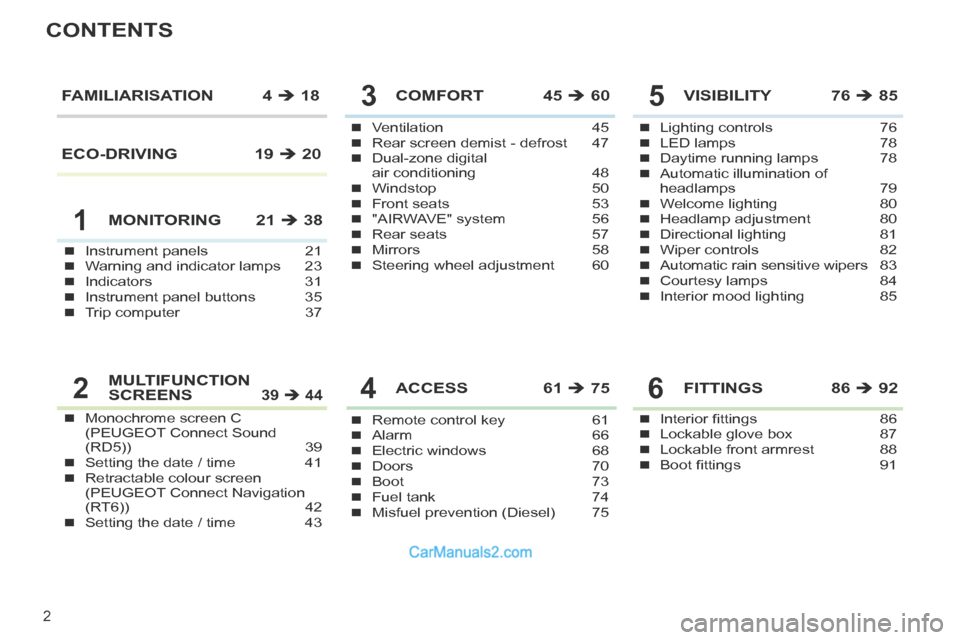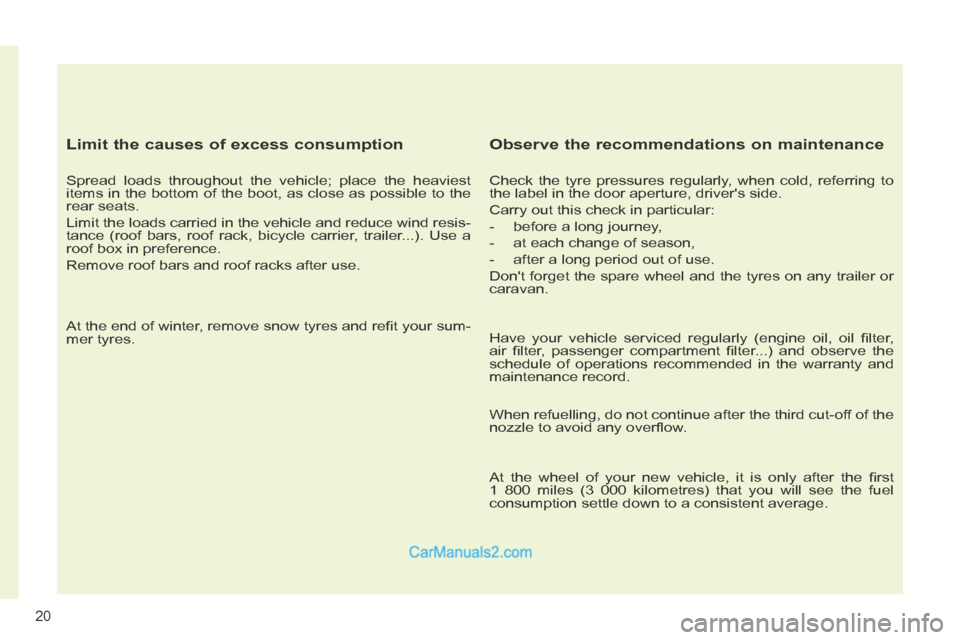Page 4 of 268

2
CONTENTS
Instrument panels 21Warning and indicator lamps 23Indicators 31Instrument panel buttons 35Trip computer 37
Ventilation 45Rear screen demist - defrost 47Dual-zone digital air conditioning 48Windstop 50Front seats 53"AIRWAVE" system 56Rear seats 57Mirrors 58Steering wheel adjustment 60
COMFORT 45 60
Remote control key 61Alarm 66Electric windows 68Doors 70Boot 73Fuel tank 74Misfuel prevention (Diesel) 75
ACCESS 61 75
Lighting controls 76LED lamps 78Daytime running lamps 78Automatic illumination of headlamps 79Welcome lighting 80Headlamp adjustment 80Directional lighting 81Wiper controls 82Automatic rain sensitive wipers 83Courtesy lamps 84Interior mood lighting 85
VISIBILITY 76 85FAMILIARISATION 4 18
MONITORING 21 38
Monochrome screen C (PEUGEOT Connect Sound (RD5)) 39Setting the date / time 41Retractable colour screen (PEUGEOT Connect Navigation (RT6)) 42Setting the date / time 43
MULTIFUNCTION SCREENS 39 44
Interior fi ttings 86Lockable glove box 87Lockable front armrest 88Boot fi ttings 91
FITTINGS 86 92
1
5
4
3
26
ECO-DRIVING 19 20
Page 5 of 268

3
CONTENTS
Direction indicators 93Hazard warning lamps 93Horn 93Emergency or assistance call 94Braking assistance systems 94Trajectory control systems 95Front seat belts 97Airbags 100Child seats 104Deactivating the passenger's front airbag 105ISOFIX child seats 110
SAFETY 93 11 3
Parking brake 114Manual gearbox 114Gear shift indicator 115Automatic gearbox 116Stop & Start 119Tyre under-infl ation detection 122Speed limiter 124Cruise control 126Parking sensors 128
DRIVING 114 129
Bonnet 131Running out of fuel (Diesel) 132Petrol engines 133Diesel engines 134Checking levels 135Checks 138
CHECKS 130 139
Temporary puncture repair kit 140Changing a wheel 145Snow chains 149Changing a bulb 150Changing a fuse 15512 V battery 161Energy economy mode 164Changing a wiper blade 165Towing the vehicle 165Towing a trailer 167Very cold climate screen 168Accessories 168
PRACTICAL INFORMATION 140 169
Petrol engines 170Weights (petrol) 171Diesel engines 172Weights (Diesel) 173Dimensions 174Identifi cation markings 175
TECHNICAL D ATA 170 D ATA 170 D ATA 176
AUDIO EQUIPMENT and TELEMATICS 177 251
VISUAL SEARCH 252 255
ALPHABETICAL INDEX 256 260
Emergency or assistance 177PEUGEOT Connect Navigation (RT6) 179PEUGEOT Connect Sound (RD5) 233
7
8
9
10
11
Page 12 of 268
10
FAMILIARISATION
INSTRUMENTS AND CONTROLS
1. Steering wheel adjustment control.
2. Cruise control / speed limiter switches.
3. Lighting and direction indicator control stalk.
4. Central adjustable air vents.
5. Multifunction screen.
6. Sunshine sensor.
7. Passenger's front airbag.
8. Glove box / Audio/video sockets / Fusebox.
9. Bonnet release.
10. Retractable roof control.
Control for all four windows.
11 . Storage compartment.
12. "AIRWAVE" system controls.
13. Front armrest.
14. Front ashtray.
15. Heating / air conditioning controls.
16. Audio and telematics system.
17. Emergency call button.
Alarm button.
Central locking button.
Hazard warning lamps button.
Dynamic stability control (DSC/ASR systems) button.
Parking sensors button.
PEUGEOT services button.
Page 14 of 268
!i
88
60
55
57
56
12
FAMILIARISATION
SITTING COMFORTABLY
Steering wheel adjustment
1. Release the adjustment mecha-nism.
2. Adjust for height and reach.
3. Lock the adjustment mechanism.
Front seats
Other functions available...
Storing of driving positions (dri-
ver's electric seat).
Electric access to the rear seats
Lockable front armrest
For your comfort, the height and the
longitudinal position of the front armrest
can be adjusted.
It also offers a storage compartment. As
a security measure when in the "cabrio-
let" confi guration, this is locked at the
same time as the rest of the vehicle, us-
ing the remote control or the key only.
As a safety precaution, these op-
erations must only be carried out
when stationary.
1. Control for release of the seat back
and automatic forward movement of
the seat.
2. Control for return of the seat to the initial position.
"AIRWAVE" system.
Heated seats.
Page 22 of 268

20
Limit the causes of excess consumption
Spread loads throughout the vehicle; place the heaviest
items in the bottom of the boot, as close as possible to the
rear seats.
Limit the loads carried in the vehicle and reduce wind resis-
tance (roof bars, roof rack, bicycle carrier, trailer...). Use a
roof box in preference.
Remove roof bars and roof racks after use.
At the end of winter, remove snow tyres and refi t your sum-
mer tyres.
Observe the recommendations on maintenance
Check the tyre pressures regularly, when cold, referring to
the label in the door aperture, driver's side.
Carry out this check in particular:
- before a long journey,
- at each change of season,
- after a long period out of use.
Don't forget the spare wheel and the tyres on any trailer or
caravan.
Have your vehicle serviced regularly (engine oil, oil fi lter,
air fi lter, passenger compartment fi lter...) and observe the
schedule of operations recommended in the warranty and
maintenance record.
When refuelling, do not continue after the third cut-off of the
nozzle to avoid any overfl ow.
At the wheel of your new vehicle, it is only after the fi rst
1 800 miles (3 000 kilometres) that you will see the fuel
c onsumption settle down to a consistent average.
Page 28 of 268

1
26
MONITORING
Low fuel level fi xed with the
needle in the red zone,
accompanied
by an audible signal and a message. When it fi rst comes on there
remains approximately
6 litres of fuel in the tank.
At this point, you begin to
use the fuel reserve. Refuel as soon as possible to avoid running out
of fuel.
Until suffi cient fuel has been added, this warning
lamp will come on every time the ignition is
switched on, accompanied by an audible signal
and a message.
This audible signal and message are repeated
with increasing frequency as the fuel level drops
towards
"0" .
Fuel tank capacity: approximately 60 litres .
Never continue to drive until you run out of fuel,
as this could damage the emission control and
injection systems.
Warning lamp
is on Cause Action/Observations
Anti-lock
Braking System (ABS) fi xed.
The anti-lock braking
system has a fault. The vehicle retains conventional braking.
Drive carefully at reduced speed and contact
a PEUGEOT dealer or a qualifi ed workshop
without delay.
Dynamic
stability control
(DSC/ASR) fl ashing.
The DSC/ASR regulation is
operating. The system optimises traction and improves the
directional stability of the vehicle in the event of
loss of grip or trajectory.
fi xed. The DSC/ASR system has
a fault. Have it checked by a PEUGEOT dealer or a
qualifi ed workshop.
Under-
infl ation fi xed.
The pressure in one or
more wheels is too low. Check the pressure of the tyres as soon as possible.
This check should preferably be carried out when
the tyres are cold.
+ fl ashing
then fi xed,
accompanied
by the Service warning lamp. The tyre pressure
monitoring system has
a fault or no sensor is
detected on one of the
wheels.
Under-infl ation detection is not assured.
Have the system checked by a PEUGEOT dealer
or a qualifi ed workshop.
Page 54 of 268
3
52
COMFORT
Pull the windstop forwards to re-lease the guides from the points,
located behind each corner of the
back of the rear bench seat.
Fold the windstop frame guides. Storing
In the storage box (version
equipped with a temporary tyre
repair kit)
Raise the boot carpet and hook its handle on the boot seal.
Store the folded windstop in the cor- responding recess in the box.
Lower the boot carpet.
In the boot (version equipped with
a spare wheel)
Stow the folded windstop securing it using the luggage retaining net.
Fold the windstop closing the two
large parts on themselves.
Unclip each end individually.
Fold each of the two parts on them- selves.
Page 62 of 268
3
!
i
!
60
COMFORT
STEERING WHEEL ADJUSTMENT
When stationary , pull the control lever to release the adjustment
mechanism.
Adjust the height and reach to suit your driving position.
Push the control lever to lock the ad- justment mechanism.
As a safety precaution, these op-
erations should only be carried out
with the vehicle stationary.
Automatic day/night model
By means of a sensor, which measures
the light from the rear of the vehicle, this
system automatically and progressively
changes between the day and night
uses.
In order to ensure optimum vis-
ibility during your manoeuvres, the
mirror lightens automatically when
reverse gear is engaged.
As a safety measure, the mirrors
should be adjusted to reduce the
"blind spot".
Rear view mirror
Adjustable mirror providing a central
rearward view.
Equipped with an anti-dazzle system,
which darkens the mirror glass: this re-
duces the nuisance to the driver caused
by the headlamps from following vehi-
cles, low sun...